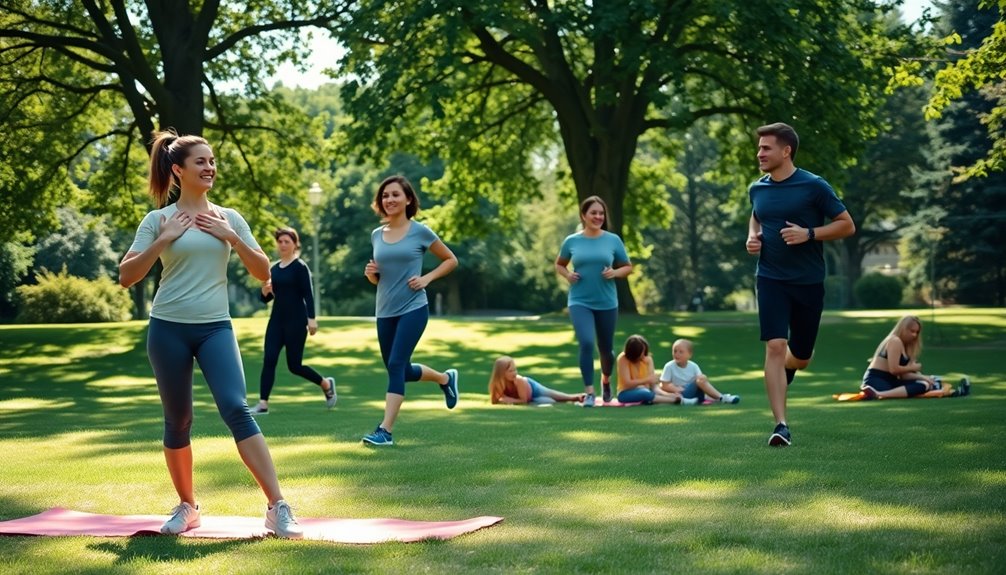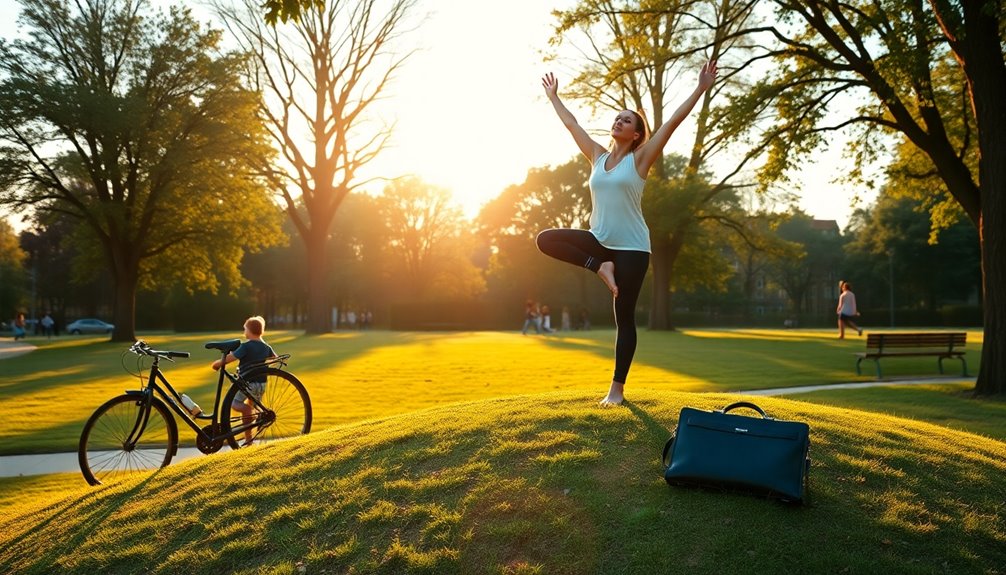Balancing exercise with life priorities means adopting a mindful approach. Start by evaluating your current commitments and setting realistic fitness goals that align with your values. Create a flexible routine that fits into your busy schedule, incorporating short, effective workouts and engaging activities that bring joy. Focus on movement throughout your day, from walking breaks to household chores. Track your progress to stay motivated, and don't be afraid to adjust your goals as needed. This method fosters resilience and promotes well-being. Discovering more about effective strategies can help you stay on track even during life's busiest moments.
Understanding Mindful Exercise
How often do you consider the impact of mindfulness on your workout routine?
Integrating mindful breathing and intentional movement can transform how you experience exercise. Instead of rushing through reps or mindlessly jogging, focus on each breath and how your body feels with every movement. This awareness helps you connect more deeply with your workouts, enhancing both physical and mental benefits. Recognizing the importance of self-care and well-being can further motivate you to prioritize mindful exercise as part of a balanced lifestyle. Additionally, practicing deep breathing techniques regularly can amplify the calming effects during your workouts.
As you engage in mindful breathing, you'll notice how it calms your mind, reduces stress, and improves your focus. When you practice intentional movement, each exercise becomes more purposeful, leading to better performance and satisfaction. Incorporating yoga and mindfulness practices can further enhance this experience, promoting inner balance and emotional well-being.
Assessing Your Current Priorities
Mindfulness in exercise can lead to a deeper understanding of what truly matters in your life. To assess your current priorities, start using self-reflection techniques that encourage you to pause and evaluate your daily commitments.
Ask yourself which activities energize you and which drain your motivation. Consider keeping a journal to track what you value most and how your time aligns with those values. This can help you identify patterns and make necessary adjustments. Engaging in gratitude practices can also enhance your focus on what truly matters, fostering a more positive mindset. Recognizing that emotional strength is vital for navigating life's challenges can further support your commitment to maintaining balance. Additionally, incorporating mindful breathing techniques into your routine can help you stay centered and focused on your priorities.
Prioritize alignment means ensuring that your fitness routine complements your other life responsibilities, rather than conflicting with them. By recognizing what's truly important, you can create a balanced approach that supports both your well-being and your life goals.
Setting Realistic Fitness Goals

When you set fitness goals, it's essential to define your objectives clearly so you know what you're aiming for. Additionally, using Key Performance Indicators (KPIs) can help you measure your progress effectively. Remember, prioritizing consistency over intensity helps you stay on track without overwhelming yourself. Setting SMART goals allows you to track your progress effectively and stay motivated throughout your fitness journey. Additionally, incorporating nutrition into your fitness plan plays a crucial role in achieving your desired outcomes.
Define Your Objectives Clearly
Setting realistic fitness goals is essential for maintaining motivation and balancing exercise with your life priorities. To achieve this, you need to define your objectives clearly.
Start by identifying what you genuinely want to accomplish—whether it's losing weight, building strength, or improving endurance. Ascertain your goals align with your lifestyle to promote objective alignment.
Break them down into smaller, manageable steps so you can monitor progress effectively. This clarity enhancement will help you stay focused and make adjustments as needed.
Prioritize Consistency Over Intensity
While achieving high-intensity workouts can be appealing, prioritizing consistency is far more essential for long-term success. Instead of pushing yourself to the max sporadically, focus on building sustainable habits that fit your lifestyle.
Start small and aim for gradual improvements; this approach keeps you motivated and reduces the risk of burnout or injury. Set realistic fitness goals that you can maintain, such as exercising three times a week instead of five.
This way, you'll create a routine that becomes part of your life rather than a chore. Remember, it's better to be consistent with lighter workouts than to struggle with intense sessions that leave you feeling defeated.
Embrace the journey, and success will follow.
Creating a Flexible Routine
Creating a flexible routine starts with establishing your prioritized goals.
You need to recognize that life changes can disrupt your plans, so being adaptable is key. Engaging in mindfulness techniques can help you stay centered during these transitions. Additionally, incorporating breathing exercises can further enhance your ability to manage stress and maintain focus. Practicing self-care practices can also support your emotional resilience as you navigate life's demands.
Establishing Prioritized Goals
Establishing prioritized goals is essential for crafting a flexible routine that accommodates both your fitness aspirations and daily responsibilities.
Start by identifying your key objectives, ensuring they align with your overall life priorities. This goal alignment will help you focus your efforts and energy.
Use motivation strategies like setting small, achievable milestones to track your progress, which can keep you inspired and committed.
Remember, it's okay to adjust these goals as your circumstances change. By regularly reviewing your priorities, you can maintain a balance between fitness and other commitments, leading to a more sustainable routine.
Embrace flexibility, and don't be afraid to make changes when necessary to stay on track with your health and well-being.
Adapting to Life Changes
As life changes—whether due to a new job, family obligations, or unexpected events—it's essential to adapt your fitness routine accordingly. Embracing these life shifts means recognizing that your previous schedule mightn't fit anymore.
Use adaptive strategies to create a flexible routine that aligns with your current commitments. Start by identifying short, achievable workouts that can easily fit into your day, like a quick home workout or a brisk walk during lunch.
Don't hesitate to adjust the frequency and intensity of your exercises based on your energy levels or time constraints. Remember, consistency is key, but it doesn't have to come at the expense of your responsibilities.
Stay mindful, and you'll find a balance that works for you.
Incorporating Movement Into Daily Life

While life can often feel hectic, finding ways to incorporate movement into your daily routine can be both simple and rewarding.
Start by taking walking breaks throughout your day, whether it's a quick stroll during lunch or a few laps around your office. Consider active commuting, like biking or walking to work.
At your desk, integrate desk stretches to relieve tension. It's important to recognize that overcoming obstacles in your routine can lead to greater resilience and personal growth, as embracing imperfection and self-acceptance fosters a more positive outlook. Turn household chores into a workout; vacuuming or gardening can keep you active.
Engage in family activities that promote movement, like playing tag or going on nature walks together. Don't forget playful workouts that bring joy, like dancing or yoga.
Finally, schedule short stretching sessions to refresh your body and mind, keeping you energized and focused. Incorporating regular physical activity into your routine not only supports mental clarity but also contributes to sustained focus throughout your day.
Utilizing Short, Effective Workouts
If you think you don't have time for a workout, short, effective sessions can fit seamlessly into your busy schedule.
High intensity intervals and quick cardio can deliver great results in minimal time.
Here are four ways to make the most of your short workouts:
- Plan: Schedule your workout like any other important appointment.
- Focus: Choose exercises that engage multiple muscle groups for maximum efficiency.
- Intensity: Push yourself during high intensity intervals to enhance calorie burn.
- Variety: Mix different cardio routines to keep things interesting and challenging.
Overcoming Common Barriers

Many people find themselves facing obstacles that hinder their ability to stay active, even when short, effective workouts are planned. The first step in overcoming these barriers is barrier identification.
Reflect on what's holding you back—whether it's time constraints, lack of motivation, or distractions. Once you pinpoint these challenges, you can implement mindset shifts to tackle them.
For instance, view exercise as an essential part of your day rather than a chore. Reframe your thoughts around fitness, focusing on the benefits to your well-being. Set realistic goals and remind yourself that even small efforts count.
Tracking Progress and Adjusting
To effectively maintain your exercise routine, tracking your progress is essential, as it keeps you accountable and motivated.
Use progress metrics to evaluate how you're doing and determine when to adjust your strategies. Here are four effective adjustment strategies:
- Set realistic goals: Break down larger goals into smaller, achievable milestones.
- Monitor your workouts: Keep a journal or app to log your exercises, duration, and intensity.
- Evaluate your performance regularly: Reflect on your progress weekly or monthly to identify trends.
- Be flexible: If something isn't working, don't hesitate to tweak your routine or switch up your activities.
Conclusion
By weaving mindful exercise into the tapestry of your daily life, you create a vibrant picture of balance and well-being. Embrace the ebb and flow of your priorities, allowing your fitness goals to dance gracefully alongside them. Like a river adapting to its banks, stay flexible and open to change. Celebrate small victories, and remember, it's not about perfection but progress. With each step, you're not just moving your body; you're nurturing your soul.



